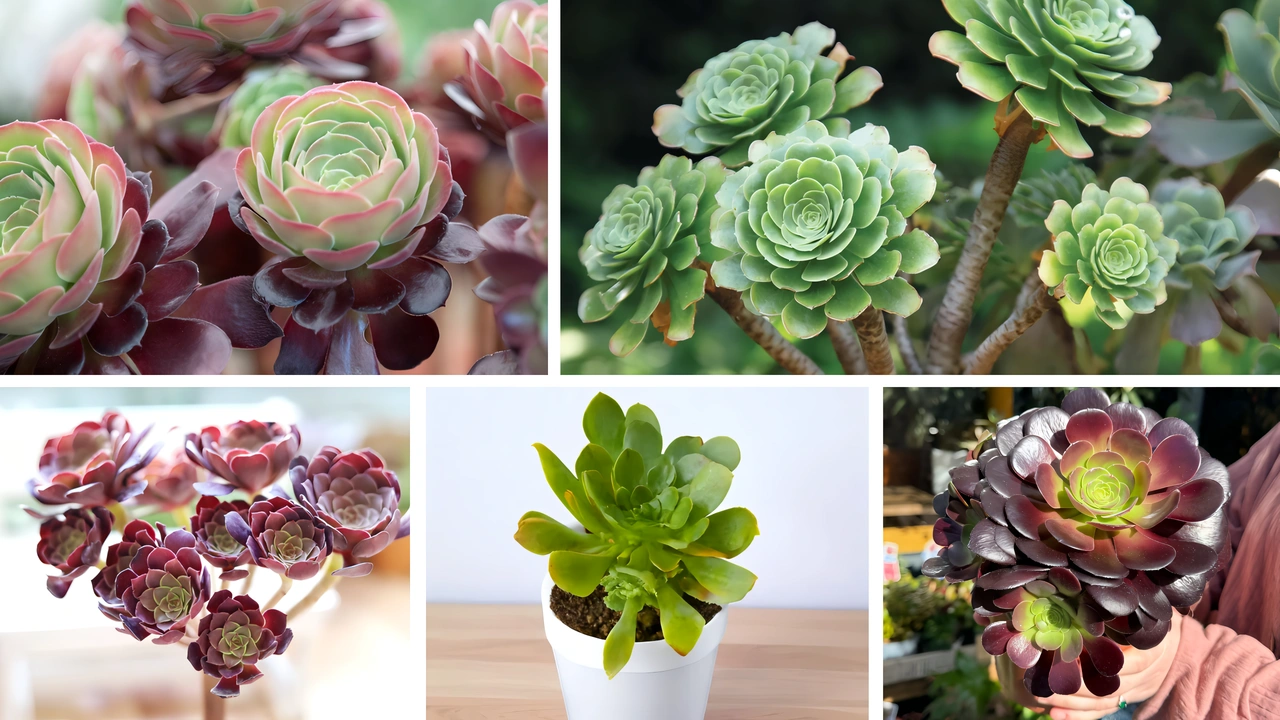Join on WhatsApp
Get the latest updates directly on WhatsApp – motivation, news & more!
Mastering Aeonium succulent care is essential if you want to grow vibrant rosettes year-round, regardless of whether you’re a seasoned succulent collector or a new plant enthusiast. Aeoniums are unique among succulents because of their striking leaf rosettes, active cool-season growth, and summer dormancy. Understanding their needs allows you to maintain vivid color, firm foliage, and healthy stems throughout all seasons. In this guide, you’ll discover how to cultivate and care for Aeoniums to enjoy their full potential indoors or outdoors, all year long.

Whether you’re growing Aeoniums for their bold texture, colorful rosettes, or architectural appeal, mastering Aeonium succulent care means adapting to their rhythm of life. Let’s dive into how to grow vibrant rosettes year-round by following plant-smart techniques tailored to these amazing succulents.
Understanding Aeoniums: The Foundation of Mastering Aeonium Succulent Care
To truly master Aeonium succulent care, it’s important to understand what makes Aeoniums different from other succulents. Aeoniums are members of the Crassulaceae family and are native to the Canary Islands, Madeira, and parts of North Africa. Unlike many other succulents that thrive in hot, dry conditions, Aeoniums prefer milder temperatures and grow primarily during the cooler months of the year. This seasonal behavior is crucial to know if you want to grow vibrant rosettes year-round.
Aeoniums grow in a rosette form, with waxy leaves that range in color from lime green to nearly black, depending on the species. They can be ground-hugging or grow tall, shrub-like stems topped with striking rosettes. Mastering Aeonium succulent care begins with aligning your watering, lighting, and maintenance routines with their biological clock.
Soil and Potting for Aeoniums: Key to Grow Vibrant Rosettes Year-Round
An essential step in mastering Aeonium succulent care is providing the right soil environment. Because Aeoniums are prone to root rot if left in soggy soil, a fast-draining mix is non-negotiable. You can use a commercial cactus and succulent mix or blend your own by combining:
- 2 parts potting soil
- 1 part coarse sand or horticultural grit
- 1 part perlite or pumice
The container you choose should have excellent drainage. Terra cotta pots are ideal because they allow moisture to evaporate. When you get the soil right, you’re laying a solid foundation to grow vibrant rosettes year-round. A healthy root zone leads to firm, colorful foliage above ground.
Watering Techniques: A Crucial Skill for Mastering Aeonium Succulent Care
Watering Aeoniums correctly is perhaps the most misunderstood aspect of Aeonium succulent care. These plants follow a unique seasonal pattern: active growth from fall through spring, and dormancy during hot summer months. Understanding this cycle is crucial if you want to grow vibrant rosettes year-round.
During active growth (cool seasons):
- Water moderately when the top inch of soil dries out.
- Avoid waterlogging the soil.
- Water less frequently than typical houseplants but more often than desert succulents.
During summer dormancy:
- Water sparingly.
- Leaves may curl or drop—this is normal and temporary.
- Never force your Aeonium to stay lush in summer through overwatering.
Following this cycle allows you to master Aeonium succulent care by giving the plant what it needs when it needs it. It also reduces the risk of overwatering, which can lead to fungal issues and dull, mushy rosettes.
Light Requirements: Ensuring You Grow Vibrant Rosettes Year-Round
Providing the right light conditions is another pillar of mastering Aeonium succulent care. Aeoniums love light, but not all light is created equal. Their color, shape, and size will all depend on the quality of sunlight they receive.
Outdoors:
- Full sun to partial shade works best.
- In very hot climates, provide afternoon shade to prevent sunburn.
Indoors:
- Place near a bright, south- or west-facing window.
- If natural light is insufficient, use grow lights for 12-14 hours per day.
Without enough light, Aeoniums will become leggy, and their vibrant rosettes will lose color and form. Maintaining strong, symmetrical rosettes means optimizing the light source, season by season. This is a non-negotiable element when your goal is to grow vibrant rosettes year-round.
Table: Aeonium Succulent Care at a Glance
| Care Aspect | Best Practice | Seasonal Notes |
|---|---|---|
| Light | Bright indirect to full sun | More sun in winter, protect in summer |
| Watering | Moderate in growth, minimal in dormancy | Reduce in summer dormancy |
| Soil | Well-draining cactus mix or DIY blend | Adjust moisture retention if needed |
| Temperature | 65–75°F (18–24°C) ideal | Protect from frost or high heat |
| Fertilizer | Light feeding in active growth (diluted succulent fertilizer) | None during dormancy |
| Repotting | Every 2–3 years or when rootbound | Best in early spring |
| Propagation | Stem cuttings or offsets | Spring or fall for best rooting |
This table encapsulates everything needed to master Aeonium succulent care and keep your plants healthy and vibrant throughout the year.
Seasonal Adjustments for Mastering Aeonium Succulent Care
Because Aeoniums behave differently in each season, adjusting your care routine is vital for growing vibrant rosettes year-round. Their most active growth happens in cooler months, so you need to tailor everything—light, water, feeding, and pruning—accordingly.
- Fall: Resume watering and introduce mild fertilizing. Sunlight strengthens as temperatures drop.
- Winter: Prime growing season. Maintain consistent care, rotate pots for even rosette growth.
- Spring: Watch for new shoots or offsets (great time to propagate). Repot if necessary.
- Summer: Expect dormancy. Limit water and place in a shaded spot. Do not panic if leaves curl.
This seasonal rhythm is your guide to mastering Aeonium succulent care and ensures you grow vibrant rosettes year-round without pushing the plant out of its natural cycle.
Pruning and Propagation: Tools to Grow Vibrant Rosettes Year-Round
Pruning and propagation aren’t just maintenance—they’re strategies for mastering Aeonium succulent care. Removing leggy growth or dried leaves helps preserve the aesthetic and health of your plants. Propagation lets you multiply your collection and share vibrant rosettes with others.
Pruning tips:
- Use clean, sharp scissors or pruning shears.
- Cut back leggy stems just below the rosette.
- Prune in fall or spring to avoid stressing the plant during dormancy.
Propagation methods:
- Allow cuttings to callous for 2–3 days.
- Plant in dry, well-draining soil and mist until roots form.
- Offsets at the plant base can also be carefully removed and replanted.
Through smart pruning and propagation, you’ll not only grow vibrant rosettes year-round but also keep your plants full, symmetrical, and eye-catching.
Troubleshooting: Mastering Aeonium Succulent Care Through Problem Solving
Even when you do everything right, challenges may arise. The key to mastering Aeonium succulent care is quick diagnosis and resolution. Here are some common issues and their fixes:
- Shriveled or curling leaves: Normal during dormancy or under-watered. Adjust water accordingly.
- Mushy stems or base: Sign of overwatering and root rot. Repot in dry soil, trim damaged roots.
- Pale rosettes or stretched stems: Not enough light. Move to a brighter location.
- Leaf drop: Normal when entering or exiting dormancy. Watch for overwatering or drastic environmental changes.
Handling these issues effectively ensures your plants stay healthy and that you continue to grow vibrant rosettes year-round.
Popular Aeonium Varieties to Help You Grow Vibrant Rosettes Year-Round
Part of mastering Aeonium succulent care involves selecting the right variety for your space and climate. Each one offers a unique twist on the classic rosette shape.
- Aeonium ‘Zwartkop’: Deep burgundy to black rosettes; striking contrast in mixed arrangements.
- Aeonium arboreum: Tree-like structure with green rosettes; classic and fast-growing.
- Aeonium haworthii ‘Kiwi’: Tricolor foliage—green, pink, and cream—on compact rosettes.
- Aeonium tabuliforme: Flat, disc-like rosettes; dramatic and best grown in shallow containers.
Knowing which types to grow lets you choose the perfect variety to suit your climate and aesthetic, helping you grow vibrant rosettes year-round with ease.
Conclusion: Mastering Aeonium Succulent Care to Grow Vibrant Rosettes Year-Round
Mastering Aeonium succulent care isn’t just about following a routine—it’s about understanding the plant’s seasonal needs, behavior, and unique beauty. From the right soil and watering techniques to optimal lighting and seasonal adjustments, every


